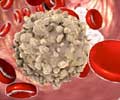Researchers developed nanorobots that selectively kill cancer cells in mice. These robots deploy a concealed weapon activated only within the tumor microenvironment

A DNA Robotic Switch with Regulated Autonomous Display of Cytotoxic Ligand Nanopatterns
Go to source). The research group at Karolinska Institutet has previously developed structures that can organise so-called death receptors on the surface of cells, leading to cell death. The structures exhibit six peptides (amino acid chains) assembled in a hexagonal pattern.
‘#Nanorobots for #cancer therapy offer a revolutionary approach by delivering targeted treatments directly to cancer cells, minimizing damage to healthy tissues. ’





“This hexagonal nanopattern of peptides becomes a lethal weapon,” explains Professor Björn Högberg at the Department of Medical Biochemistry and Biophysics, Karolinska Institutet, who led the study. “If you were to administer it as a drug, it would indiscriminately start killing cells in the body, which would not be good. To get around this problem, we have hidden the weapon inside a nanostructure built from DNA.” DNA Origami: Crafting Nanoscale Structures with Precision
The art of building nanoscale structures using DNA as a building material is called DNA origami and is something Björn Högberg’s research team has been working on for many years. Now they have used the technique to create a ‘kill switch’ that is activated under the right conditions.“We have managed to hide the weapon in such a way that it can only be exposed in the environment found in and around a solid tumour,” he says. “This means that we have created a type of nanorobot that can specifically target and kill cancer cells.”
The key is the low pH, or acidic microenvironment that usually surrounds cancer cells, which activates the nanorobot’s weapon. In cell analyses in test tubes, the researchers were able to show that the peptide weapon is hidden inside the nanostructure at a normal pH of 7.4, but that it has a drastic cell-killing effect when the pH drops to 6.5.
They then tested injecting the nanorobot into mice with breast cancer tumours. This resulted in a 70 per cent reduction in tumour growth compared to mice given an inactive version of the nanorobot.
Advertisement
The researchers also plan to investigate whether it is possible to make the nanorobot more targeted by placing proteins or peptides on its surface that specifically bind to certain types of cancer.
Advertisement
Reference:
- A DNA Robotic Switch with Regulated Autonomous Display of Cytotoxic Ligand Nanopatterns - (https://www.nature.com/articles/s41565-024-01676-4)
Source-Eurekalert














